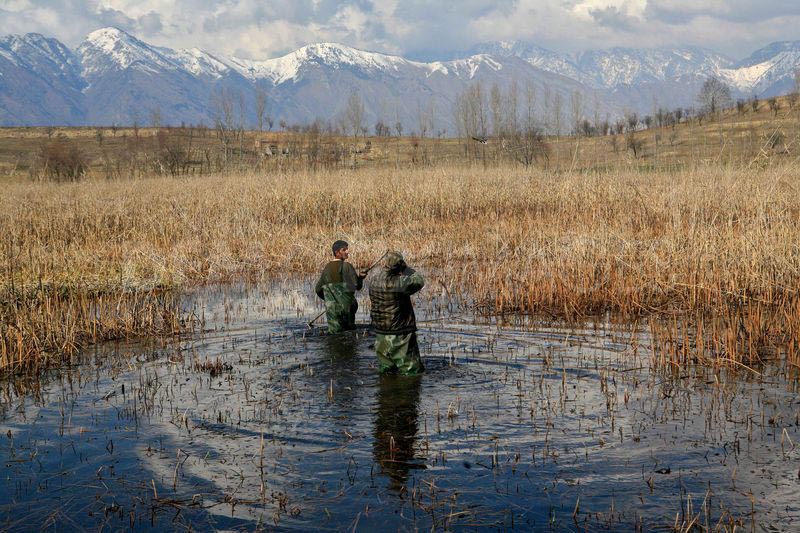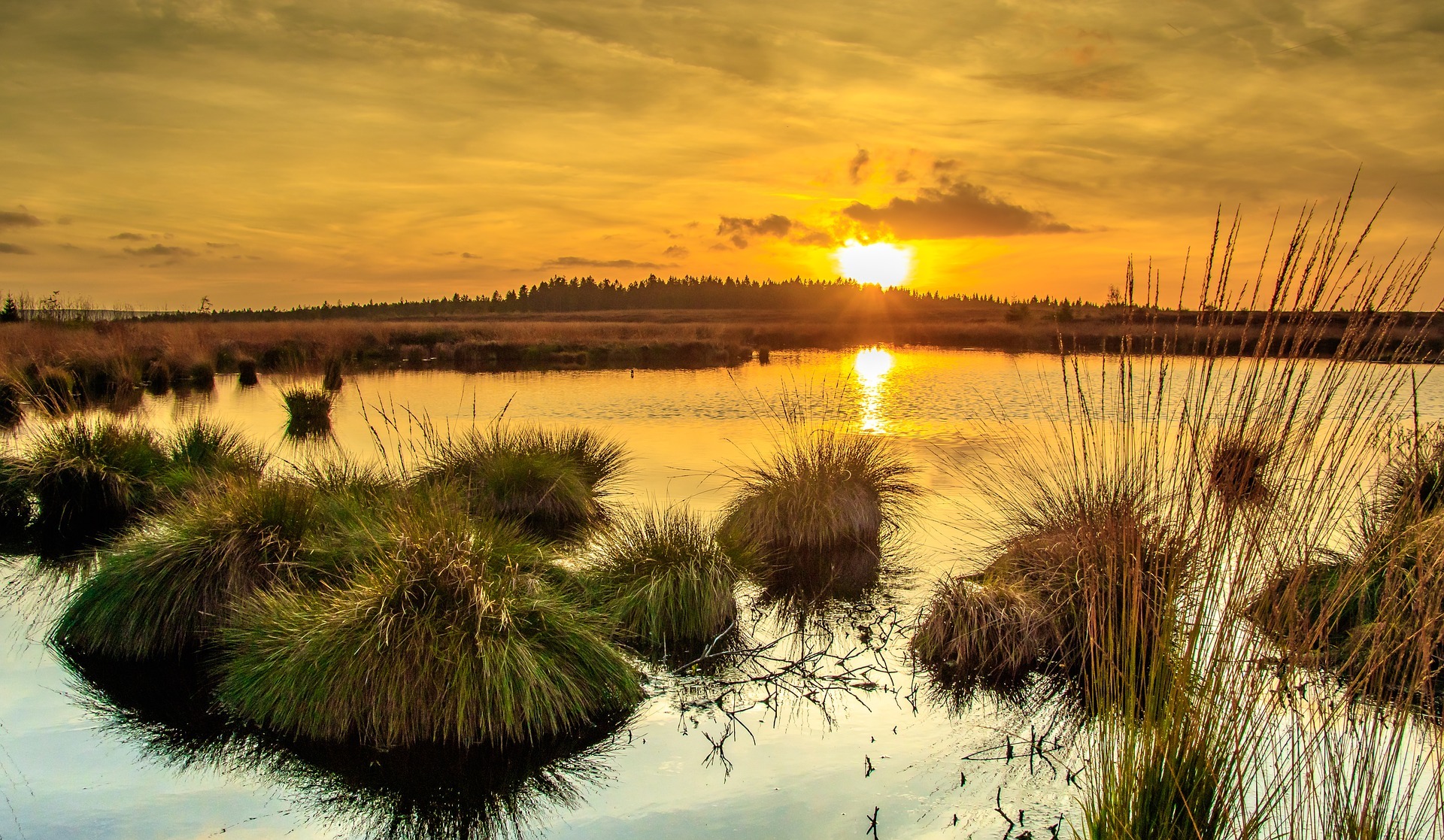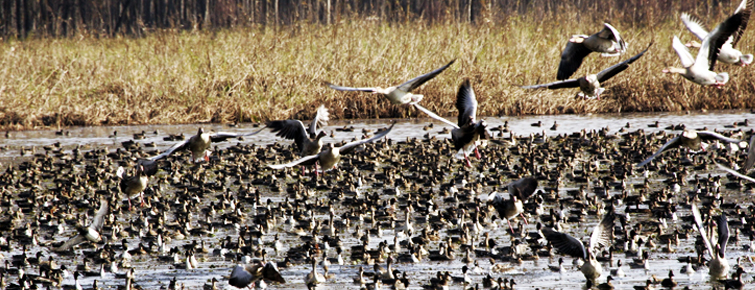
Divisional Commissioner Kashmir, Pandurang K Pole recently directed officials to ensure removal of all encroachments within 45 days period from wetlands. But a quick follow-up revealed a deep-rooted mess in the shrinking wetlands of the valley.
ON August 13, 2020, Kashmir’s bureaucratic battery penalized the swelling wetland crisis in Kashmir. Driven by the belief of “resting all violations”, the officials headed by Divisional Commissioner Kashmir PK Pole reviewed the progress—demarcation, land transfer, installation of boundary walls, pillars, removal of encroachments and non-dumping of solid waste—of Hokarsar, Wular and Kreentcho-Chandhara wetlands.
Pole instructed officials to take stringent action including register FIRs against the offenders indulging in repeated illegal activities. He directed concerned to constitute committees and activate field staff teams for close monitoring of wetlands.
But Wetlands are Shrinking
Despite the official stiff stand, the wetlands in Kashmir are shrinking at an alarming rate.
According to “National Wetland Atlas: Jammu and Kashmir” released in 2010, there are 3651 wetlands covering 3,91,501 hectares in the then undivided state of Jammu and Kashmir, out of which 2240 wetlands have an area less than 2.25 hectares.
The Narkara wetland located on the outskirts of Srinagar has shrunk from 22.63 square kilometers (sq km) in 1965 to a mere five sq km in 2016. Another wetland, the Hokersar, also known as the queen of wetland, has lost 5.75 sq km from 1969 to 2008. Brari Nambal, a marshy lagoon in Srinagar which covered an area of 1 sq km in 1971 has reduced to 0.77 sq km by 2002.
According to a study by researcher Shahid Ahmad Dar on the current status of wetlands in Srinagar, the major threats to wetlands include pollution, land use and land cover changes, urbanization, encroachments, and climate change.
“The intensive agricultural practices, the introduction of exotic species, and changes in hydrological flows during the past few decades have resulted in degradation of wetlands over this region,” mentions the study.
Kashmir has a large number of wetlands due to its peculiar geomorphic setup, says Dr. Shakeel A. Romshoo, Dean of Research at the University of Kashmir. These wetlands have significant hydrological functionality and provide a livelihood to many Kashmiris.

“Unfortunately,” Romshoo told Kashmir Observer, “over the past 50 years these wetlands are converted into wastelands not just by the people but also by the government.”
Whenever there is a requirement of land for infrastructure development project, the first casualty are the wetlands, complains the Dean of Research.
What about deadline
DivCom Pole also directed concerned officials recently to remove all encroachments from the wetlands within 45 days.
On being asked about the deadline, Romshoo says that the encroachment cannot be changed all of a sudden by a directive of 45 days unless it is supported by a policy decision.
“A strong institutional mechanism should be created to prevent the conversion of a wetland into a non-wetland,” he says.
The Dean of Research believes that if officials really appreciate the functionality of wetlands they should have a conservation policy for them. “Ideally we should have a wetland management plan for all the wetlands,” says Romshoo.
Though there is an authority for the management of Dal Lake, he says, what about the rest 3650 wetlands in Kashmir?
Misplaced Priority
According to a study by Sheikh Aneaus and Irfan Rashid, the catchment area of Narkara, a semi-urban wetland, has drastically shrunk over the years. People living near wetlands convert it into agricultural land which has resulted in the reduction of the aquatic habitats, the study notes.
According to Romshoo, the main problem in Kashmir is that environmental governance has never been a priority and it is deteriorating for the last 40 years.
“The government needs to create a holistic approach to protect the wetlands especially those in the vicinity of the urban population,” he says.
He believes that nature is more complex than a human body and as the doctor prescribes medicines for treatment after proper examination, the government and researchers should also study the wetlands and provide a prescription for it.

Wetlands of Kashmir are the centers of attraction for European, Central Asian, and Chinese migratory birds from centuries.
Extreme freezing climatic conditions during winters in Northern Europe, China, and Central Asian countries make it unsuitable for the migratory birds and these birds find Kashmir’s climate favorable to be their adobe.
Buffer System
Sakib Qadri, Convener at People’s Environmental Council, says that wetlands are important for survival because they act as a “water kidney” which protects flooding.
“The gradual reduction of wetlands is affecting their buffering capacity to withhold floodwaters and stormwater runoff,” says Qadri.
The effect was seen in the 2014 floods in Kashmir—when residential areas in the outskirts of Srinagar, which used to be traditional floodplains, were submerged in water for more than three weeks, says the convener.
Qadri believes that the real question behind the encroachment of the wetlands is why the encroachers were allowed to deteriorate the area for such a long time. He suggests that the authorities must work to prevent pollution and sediment loads from reaching the wetlands and protect them for being misused.
The open dumping of waste into the wetlands by the Municipal Authorities and people living in the vicinity have tremendously affected the flora and fauna.
“Sometimes the vehicles of municipality don’t even come to take the waste,” complains Mushtaq Pahalgami, an environmental activist based at Pahalgam. Because of which people throw garbage in the open.
According to a study by Faculty of Fisheries at Sher-e-Kashmir University, the fish catch as well as the diversity has reduced in the Hokersar Wetland. Most probably the wetland ecosystem is not getting adequate time to recover its natural community structure, notes the study.
Like other departments where there is a strong policing by the government, Pahalgami believes, a state-level wetland Development Authority is needed to protect the “water kidney” from being further damaged.
Follow this link to join our WhatsApp group: Join Now
Be Part of Quality Journalism |
Quality journalism takes a lot of time, money and hard work to produce and despite all the hardships we still do it. Our reporters and editors are working overtime in Kashmir and beyond to cover what you care about, break big stories, and expose injustices that can change lives. Today more people are reading Kashmir Observer than ever, but only a handful are paying while advertising revenues are falling fast. |
| ACT NOW |
| MONTHLY | Rs 100 | |
| YEARLY | Rs 1000 | |
| LIFETIME | Rs 10000 | |













